Maintenance and care
Optimal conditions of detention
Whether it is an amateur or professional florist, each of them wants their orchid to bloom longer and develop well. No special action is required for this. It is necessary to observe the required regimen to ensure the full development of the plant and its buds.
When creating growing conditions, the main attention should be paid to:
lighting. Maintain a constant intensity and amount of daylight throughout the year. Our climatic conditions do not allow the exotic plant to maintain 10-12 hours of daylight hours, especially in winter. Therefore, it is necessary to increase it due to additional lighting with phytolamps. Any changes in illumination affect the number of peduncles, buds and, of course, the very duration of flowering;
Important! Natural light should be diffused. Direct sunlight is unacceptable.
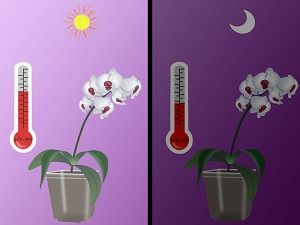
- temperature. The optimal temperature for phalaenopsis is considered to be an interval of 15-25 ° C. The main thing is to achieve constancy - 20-25 ° C in summer, and 18-20 ° C in winter. It is a 5-6 ° difference between night and day temperatures that affects the duration of flowering;
- humidity. This parameter in modern home conditions has practically no effect on development. The main thing is not to allow too dry, less than 30% and too humid, more than 80% air. For this hybrid, a slightly higher humidity is recommended. Therefore, it is necessary to periodically spray, but at the same time avoid getting moisture on the flowers and buds.
The room should be constantly ventilated, but drafts should not be allowed, which adversely affect the orchid.
Watering and feeding
Recommended watering for Phalaenopsis Manhattan in spring and summer is once a week. Experienced orchidists recommend producing it with warm water, neutral in acidity (preferably rain or melt water) on the surface of the substrate, while avoiding accumulation on the surface of the water. Watering should be done at a time when most of the roots will acquire a silvery-gray color.
In the autumn-winter period, watering should be reduced to once every 10-14 days.
Top dressing or additional feeding should be carried out once a month or at every third watering with special fertilizers for orchids, strictly following the instructions attached to them. It is even better to reduce the concentration by 2-4 times than to overfeed the orchid.
It is watering and feeding that are the most common mistakes when caring for phalaenopsis.

Determination of the need for watering.
After shopping in the store
After purchase in a store, orchids are usually not transplanted, since they acquire mainly a flowering plant. A transplant is carried out only if there are any problems in the root system or the presence of insect pests in it.
Care after purchase consists only in acclimatization under new conditions. Watering, nutrition and, preferably, temperature are reduced slightly. After about 2-3 weeks, if the plant is developing well, care is carried out according to all the rules.
After flowering
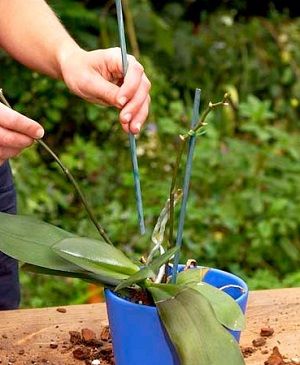 Post-flowering care requirements depend on the condition of the peduncle. There are only two options:
Post-flowering care requirements depend on the condition of the peduncle. There are only two options:
- As soon as all the flowers fall off, the flowering arrow begins to dry. From this it follows that the plant gave up all its strength and nutrients, deciding to rest, gain strength. You need to wait until the peduncle is completely dry, giving away the rest of the nutrients, and only then cut it off;
- The flowers have fallen off, and the arrow does not develop, does not dry out or is partially withered. In this case, you can do nothing.It is likely that the peduncle can release another flower or even flowers. Or you can cut the arrow 1-1.5 cm above the dormant bud. This will stimulate it to form a baby or a new lateral peduncle.
Maintenance should continue as normal, except for a reduction in the supply of auxiliary power.
If the plant has been in the substrate for more than 2-3 years, this is the best time to transplant the orchid into a new substrate and container.
Recommendation! After the flower-bearing arrow is completely dry, it is better to cut it off.
Step by step instructions for home care
The plant thrives best on the southeast, west, or southwest side. The north will not provide enough light if you do not use additional lighting. And the south window poses a threat in summer, as the plant needs to be shaded.
A rare flower is picky about the conditions of detention. The room should be as close as possible to the natural habitat.
Preparing the soil and pot
To grow phaleropsis, a special soil is needed, which must meet the following criteria:
- Have good breathability.
- Be firm to support the plant.
- Dry quickly.
- Retain nutrients.
- Do not undergo destruction of the structure for as long as possible.
Ready-made substrate can be purchased in the store or made independently from pine bark, sphagnum and peat moss, charcoal, expanded clay. Poor quality soil will destroy the flower, so you need to buy a substrate in a specialized store.
The container for phalaenopsis should be transparent, this is a key rule when choosing. Since the roots are involved in photosynthesis, they also need light. There should be enough holes in the pot, not only at the bottom. The best option would be a plastic pot.
Temperature, humidity and lighting
- The difference between day and night temperatures should be small. In summer, it is necessary to adhere to a temperature of 25-30 ℃, in winter about 20 ℃.
- The flower requires a moisture content of at least 50%. Drafts are not allowed, but the room must be ventilated.
- The wild cat loves bright lighting. Light children for a plant should last an average of 12 hours at any time of the year. It is desirable that the light be natural, but artificial lighting with LED or fluorescent lamps is also allowed.
Watering
Watering is an important care item. Orchids tolerate drought more easily than waterlogging. Therefore, you need to let the soil dry out between waterings.
Watering should be carried out at least 2 times a week according to the principle of watering, drying, watering. Constant moisture in the soil will lead to root rot. The flower should be watered during the day without getting into the center.
The less light and heat the plant receives, the less often it needs to be moistened.
Top dressing
- Experienced growers recommend feeding the plant every third watering using a fertilizer concentration. For top dressing, special fertilizers "For Orchids" are used.
- In the stage of active growth of roots and leaves, phalinopsis is fed with nitrogen-containing mixtures.
- In the period of a set of buds and flowering compounds with phosphorus and potassium. These substances improve the process of photosynthesis.
Too active feeding during the flowering period reduces its duration. After all the buds have opened, the dressing is reduced to 1 time in 30 days.
Transfer
A wild cat should be transplanted no more than once every two years. The best time for this is spring. Phalaenopsis do not tolerate transplants well, so more often a plant can be transplanted only if:
- too small pot;
- the roots began to rot;
- the flower is not stable in the soil.
To transplant a plant without harming it, you need to follow these tips:
- It is better to cut the old pot rather than pulling out the flower.
- The drainage in the new pot should be 2-3 cm.
- Before planting, the pot must be immersed in warm water with fertilizers for 2-3 minutes.
- At the end of the transplant, place the flower in a bright and warm place.
When transplanting, you need to study the roots and remove all rotten ones.
Landing
Due to its decorative effect and the ability to easily cross with other varieties and hybrids, phalaenopsis giant has gained immense popularity and is successfully grown in botanical gardens, greenhouses, and also in an apartment.
Priming
Like all orchids, he loves light, nutritious, breathable soil. When transplanting, the substrate should easily crumble from the roots.
It usually includes:
- Pieces of pine bark 2-3 cm in size;
- Expanded clay;
- Charcoal (preferably birch) coal;
- Solid sphagnum moss.
Also, a ready-made substrate can be purchased at a specialized store, adding a few threads of whole moss to it.
Sometimes phalaenopsis in a basket is grown on pure New Zealand moss. In such a substrate, the plant can grow without replanting for many years.
Optimal capacity
Plant a giant phalaenopsis in an orchid pot, basket, or on a block.
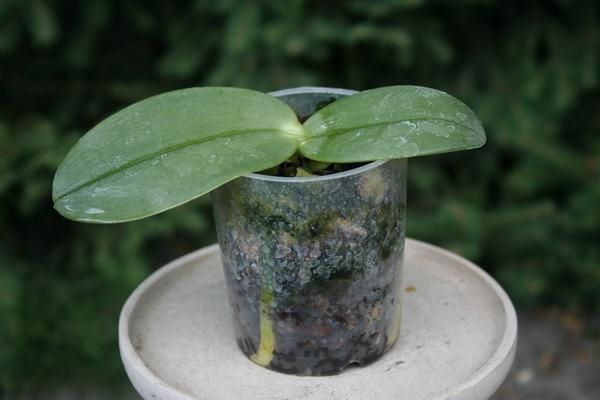
A transparent pot for a still small Giant.
When choosing a pot, you should pay attention to its characteristics:
- Mandatory presence of drainage holes;
- The volume of the pot should be such that the roots are freely located and do not touch the walls;
- The container material must have good thermal insulation properties, otherwise the roots will overheat;
- Transparent walls will allow you to monitor the state of the root system.
A giant phalaenopsis, planted in an orchid basket or block, looks very impressive, since in this case its growth is similar to growing in natural conditions.
However, it must be borne in mind that growing on a block is inconvenient due to the large size of the plant and the need for daily watering.
Craftsmen also cultivate Giant Phalaenopsis entirely in water.

Growing Gigantea in water.
And here is a video on this topic, however, in English (about growing in water starts from about the middle of the video):
Correct fit and transplant
Soil selection
 The soil or as it is correctly called - the substrate is the guarantor of the stability, development and nutrition of the orchid. You can buy it ready-made in almost any flower center.
The soil or as it is correctly called - the substrate is the guarantor of the stability, development and nutrition of the orchid. You can buy it ready-made in almost any flower center.
In the absence of the opportunity, it is easy to prepare it yourself, the main thing is to choose high-quality and correct components in proportion:
- tree bark (preferably pine), well-boiled or calcined, with a fraction of 1.5-2 cm;
- charcoal;
- sphagnum moss;
- inert materials: perlite, vermiculite, expanded clay or foam.
Coconut chips and fibers are also used.
Advice! A small amount of peat is used, reducing the alkalization of the soil from irrigation with hard water.
Optimal capacity
The phalaenopsis root system is involved in photosynthesis, so the container must transmit light. Plus, for good aeration, ventilation of the roots, the optimal amount of air must be supplied.
Transparent plastic pots are ideal for growing these types of orchids, on which you can easily make the required number of drainage and ventilated holes.
Also, the root system prefers a little tightness. Due to this property, the size of the pot is 2-3 cm wider than the root part.

Transparent plastic pots are best suited for planting.
Technology
Timely and adequate transplantation has a beneficial effect on the development of the orchid. Even during the flowering period, a correctly done transplant will not have a tangible effect.
Usually, the plant is transplanted after flowering, every 2-3 years, to replace the decomposed, compacted and non-providing substrate with the necessary processes.
Or with a large growth of the root system, which no longer fits into the container.
Another important reason for transplanting is painful processes in the root of the plant.
The transplant procedure includes primarily:
- careful extraction of the plant from the container;
- soaking and inspection of the roots;
- root treatment from dry, damaged areas;
- processing of cuts with activated carbon;
- drying.
 In a new prepared container, a drainage made of inert materials, about 2 cm thick, is laid on the bottom.A bark is laid on it in a small layer, with a larger fraction - 2-3 cm, which is pre-sprayed with water.
In a new prepared container, a drainage made of inert materials, about 2 cm thick, is laid on the bottom.A bark is laid on it in a small layer, with a larger fraction - 2-3 cm, which is pre-sprayed with water.
Then the root system is lowered into the container and the inter-root space is filled carefully so as not to damage the roots. It is better to use a wooden stick for this procedure to lightly tamp the substrate throughout the entire volume of the pot.
The root collar is not deepened. If necessary, in case of dry indoor air, the surface is mulched with sphagnum moss. After planting, the plant is not watered for 3-4 days.
Useful Tips
Anyone who wants to successfully grow these wonderful flowers at home should carefully read and remember the following recommendations of the most experienced florists.
- Do not move orchids in subzero outdoor temperatures. The ideal temperature recommended for transporting these plants is not lower than 13-16 degrees Celsius.
- Get special orchid soil and pot containers from the store immediately in case the plant needs an urgent transplant.
- In an active, healthy plant, all parts are always proportional and harmonious.
- When you have brought your orchid home, do not rush to remove the packaging. Place the flower away from heating appliances and let it sit for a few hours to acclimate.
- If the soil is not overdried, then do not water the purchased plant for 3-5 days.
- It is best to place orchids on the eastern side of the home and keep them isolated from other flowers for the first month.
When choosing an orchid, always consider your home microclimate and interior features. These charming flowers, when strategically located and daily cared for, can transform your home into a fabulous fragrant space. In addition, the contemplation of the beautiful is stress therapy that is so necessary for all of us in an age of rapid speeds.
Tips for choosing an orchid are waiting for you in the next video.
Detailed description
The second name of this variety is "black orchid". However, this name does not correspond to the actual color of the plant. This "black" effect is achieved through the saturation of burgundy, purple and beetroot colors. The petals are highly dense, saturated with wax, so they seem to shine and shimmer in the light.
The height of this orchid is considered medium - the stem can grow up to 0.2 meters and usually this stem is completely hidden by leaf plates. Leaves, in turn, can reach 22 centimeters in length and 8-10 centimeters in width. The shade of the leaf blades is very rich, dense, dark green. Sometimes the leaves can be smaller, but this usually occurs in young plants.
The flower arrow grows from a leaf rosette. Sometimes the peduncle is branched. In most cases, Kaoda has two peduncles. On one such arrow, up to a dozen flowers can bloom, with proper care, there can be fifteen buds. The diameter of the flowers is 4-5 centimeters.
The buds have petals of the correct shape, beet or purple. In some cases, there are petals with a white border. The lip is white, in rare cases with purple splashes. At the end, the lip bifurcates.
Reference! There is no dormant period for this orchid variety. It can bloom all year round. However, most often the buds bloom in the spring-summer season.
Kaoda is distinguished by its excellent light aroma. But you can only catch the smell at lunchtime.
Features of the vanilla orchid and its suitability for growing in room culture
Vanilla is a separate genus in the orchid family, including about a hundred species.Only three of them are grown for pods, and only one is adapted to the pot culture - Vanilla planifolia or flat-leaved vanilla (planifolia).
Flat-leaved vanilla outwardly differs greatly from indoor orchids familiar to flower growers. This plant can be identified by the following distinctive features:
- life form - a branching liana capable of growing up to 15 meters;
- has branched shoots up to 1-1.5 cm thick, covered with numerous elliptical pointed leaves of a dense structure;
- has ground roots buried in the soil and epiphytic, growing to tree trunks;
- from the axils of the leaves produces multi-flowered racemose inflorescences with yellow-green flowers up to 6-10 cm in diameter;
- flowers have a characteristic vanilla aroma, have a funnel-shaped, slightly corrugated, orange-yellow lip.
In culture, two forms of vanilla have become widespread - green and variegated planifolia. In the first, the leaf plates are evenly colored bright green. The second has contrasting longitudinal stripes on the leaves.
Monitoring reviews of orchid growers shows that vanilla orchids are generally suitable for indoor cultivation, albeit with some reservations:
Indeed, before purchasing a stalk of a vanilla orchid, you need to adequately assess the capabilities of your apartment. It gives vegetative growth at a high rate, but blooms only on shoots that have reached a length of at least 5-7 meters. Therefore, home flowering from this plant is rarely obtained.
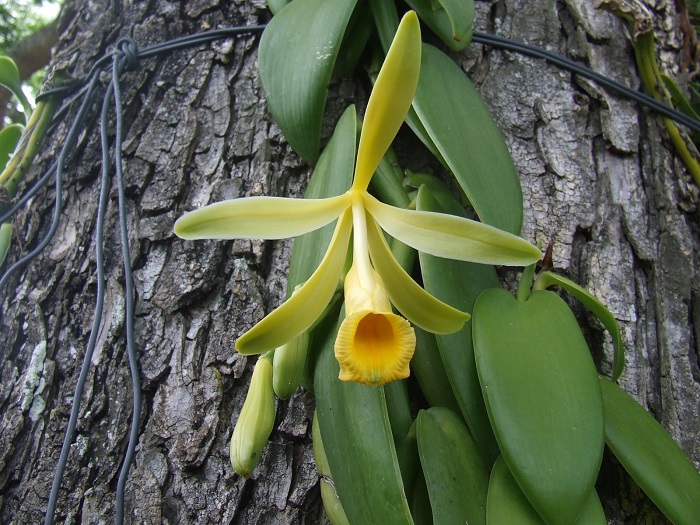 Each vanilla orchid flower lives no more than a day. This imposes another limitation on obtaining pods from a houseplant. But his flowers bloom in turn, and the total duration of flowering can be long. In nature, planifolia blooms all year round.
Each vanilla orchid flower lives no more than a day. This imposes another limitation on obtaining pods from a houseplant. But his flowers bloom in turn, and the total duration of flowering can be long. In nature, planifolia blooms all year round.
Diseases and their treatment
Yellowing, lethargy of leaves
Causes:
- natural dying off;
- competition from other plants;
- lighting;
- lack or excess of fertilizers;
- incorrectly selected container;
- watering error;
- diseases and pests.

Yellowing due to natural causes.
Each case must be dealt with separately. Most leaf problems are due to improper care. Providing proper care, the orchid will quickly restore the turgor of the leaves. Disease and parasite control should be treated with appropriate medications.
Black dots on the leaves
Important! The main reason for the appearance of black dots on leaf plates is care errors and fungal diseases.
In care, this may be due to sunburn or burns from reagents that growers spray the plant with.
If the tendency for the development of black dots, subject to all the conditions of care, does not stop, then urgent measures should be taken to treat the orchid from a fungal disease.
Less often, but still happens, the appearance of such points is associated with bacterial diseases. In this case, one cannot do without chemicals and plant isolation.
Roots rotted, how to save?
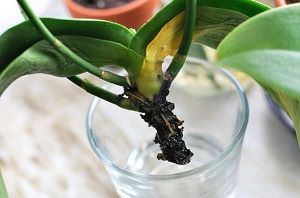 Orchid plants are distinguished by good vitality. Even if the root system is almost completely rotted, if there is even a little living space left, then it can be saved.
Orchid plants are distinguished by good vitality. Even if the root system is almost completely rotted, if there is even a little living space left, then it can be saved.
Places damaged by rot are cut off, treated with antiseptic preparations or activated carbon and dried well.
Further actions depend on the extent of the damage. The orchid is either planted in a new substrate, or sinks into the moss during the growth of new roots.
Care
The giant phalaenopsis is very picky about the conditions of detention in the room.
Optimal conditions of detention
For good growth and normal flowering at room content, it needs to provide favorable growing conditions:
- The optimum cultivation temperature is in the range of 22-30 ℃ with a mandatory daily temperature fluctuation of 5-8 ℃.The plant does not tolerate well if the room temperature drops below 15 ℃;
- Lots of ambient light, much more than most other orchid species. In winter, the orchid is placed on the lightest window, as it grows year-round;
- The required air humidity in the room is 60-85%. To maintain optimal humidity, you can use a humidifier or put an orchid pot on wet expanded clay;
- The plant loves good air circulation so that moisture evaporates quickly from the leaves.
When creating favorable conditions for the giant phalaenopsis, he will thank him with good growth and extraordinary flowering.
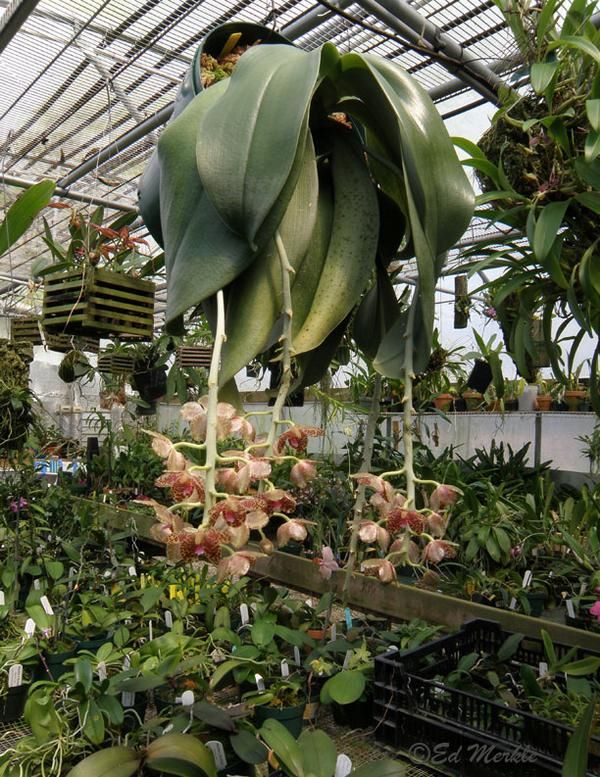
And here's another giant. Other photos and a description of this instance can be found here.
Advice! If the orchid does not grow well, pay attention to the light. The right location plays an important role in the health and well-being of the plant.
Transfer after purchase
After purchasing phalaenopsis, it is not recommended to transplant. This can only be done if rotten roots are visible.
The plant is best placed in diffused light, away from other indoor plants. At first, it is not recommended to water and feed it.
If no diseases were detected during quarantine, then after 10 days the plant can be put in a permanent place and watered.
Watering and feeding
Like other orchid species, the giant phalaenopsis is very sensitive to watering:
- Water the phalaenopsis as the substrate dries. It is better to do this in the morning so that the water that remains on the leaves dries up by evening. Watering is carried out 1 time in 7 days, while being careful not to cause waterlogging of the substrate;
- For watering, the pot with the plant is placed in a container filled with water to 2/3 of the height of the pot, left to stand for 15 minutes. After the roots are saturated with water and have acquired a bright green color, the pot is exposed to the surface for 30 minutes to allow the water to drain;
- A good outflow of water can be ensured by placing the pot at a slope of 35-40o;
- With insufficient lighting in the winter, the watering and feeding regime of the orchid is reduced.
Attention! It is necessary to ensure that no water accumulates at the growth point of the giant phalaenopsis, as this can lead to decay of the orchid.
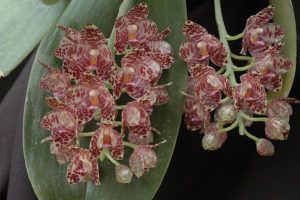 Top dressing is carried out with a highly diluted fertilizer for orchids.
Top dressing is carried out with a highly diluted fertilizer for orchids.
For phalaenopsia growing on different substrates, different types of fertilizers are used:
- On a substrate of live sphagnum moss, foliar feeding with fish fertilizer is applied (0.1 teaspoon per 3.8 l of water). In this case, chemical fertilizers cannot be used, this can lead to the death of the substrate;
- On a bark substrate, the plant is fed with ½-1/4 doses of fertilizer for orchids.
Top dressing is carried out during every third watering of the phalaenopsis.
Stimulating flowering
To stimulate the flowering of giant phalaenopsis, the plant needs daily temperature fluctuations.
Optimal differences should not exceed 5-8 ℃: from 30-31 ℃ in the daytime to 22-23 ℃ at night.
Attention! The main condition for the regular flowering of an orchid is optimal maintenance conditions and proper care.
Prevention of diseases and pests
In order for the orchid to grow healthy, it is necessary to ensure that water does not fall on the leaves during watering and does not stagnate in the leaf sinuses, as this can cause damage to bacterial rot.
A particular danger is the decay of the growth point. To prevent this from happening:
- After watering, water from the surface of the sheet must be blotted with a paper towel;
- To prevent water from accumulating at the base of the leaves, it is better to put the container for orchids or hang it at an angle of 40-45o.
On rainy days, after watering, a fungicide can be sprayed onto the plant to prevent rotting.
Diseases of the orchid Zigopetalum and resuscitation
The most dangerous pest is the spider mite, which can be eliminated by treatment with a strong stream of water. To prevent its appearance, it is worth adding lime to the irrigation water.
The most dangerous diseases are rotting, fungus and bacterial diseases. They are easier to prevent than to cure, so you should provide the flower with the right conditions without excess moisture, which is the provocateur of the spread of many diseases.
Resuscitation represents an improvement in the conditions for keeping a flower. Establishing a watering and fertilizing regime. However, effectiveness depends on how early the problem is discovered. The faster, the higher the likelihood of a complete recovery. To rescue, take the following steps:
- replace the soil;
- change the type of fertilizer used;
- change daylight hours.
To reanimate the plant, it is imperative to cut off the damaged parts. Treat the trimming points with potassium permanganate or charcoal. Transplant an already completely healthy plant into the new land.
 You may be interested in:
You may be interested in:
Is there a blue orchid in nature? How to care for an orchid Orchids are perhaps the most attractive plants in the world and are popular with flower lovers in every ... Read more ...
Zygopetalum is a sensitive plant that needs attention. By organizing regular watering, fertilization, the florist helps the flower grow and develop with dignity.


